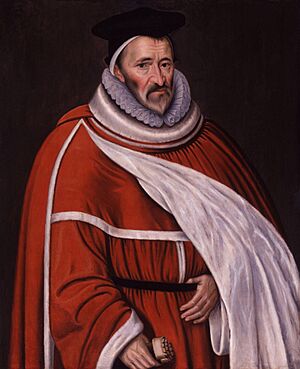Edmund Anderson (judge) facts for kids
Sir Edmund Anderson (born around 1530, died August 1, 1605) was a very important judge in England. He served as the Chief Justice of the Common Pleas during the time of Queen Elizabeth I. He was also one of the judges during the famous trial of Mary, Queen of Scots.
Contents
Sir Edmund Anderson's Early Life
The Anderson family originally came from Scotland and then moved to Northumberland in England. They settled in Lincolnshire in the 1300s and became a well-known family there.
Sir Edmund Anderson was born in Flixborough, Lincolnshire, around 1530. His father was Edward Anderson. Edmund first studied in the countryside. Then, he spent a short time at Lincoln College, Oxford, before joining a law school called the Inner Temple in June 1550. He also studied at St John's College, Cambridge, in 1549.
Becoming a Judge
In 1577, Anderson became a Serjeant-at-Law, which was a senior lawyer. In 1578, he was made the Queen's Sergeant, meaning he was a top lawyer for the Queen.
In 1581, he became a Justice of Assize in the Norfolk area. He was known for being very strict, especially in cases involving certain religious groups like Catholics and Puritans. This strictness became a pattern throughout his career as a judge.
Because of his success, Anderson was made Chief Justice of the Common Pleas in 1582. This was a very high position in the legal system. He was also knighted, which meant he was given the title "Sir." He continued in this important role even when King James I came to power, and he held the job until he died.
Important Trials and Cases
During his time as Chief Justice, Sir Edmund played a big part in some of the most important trials of Queen Elizabeth's reign. He was involved in the trial of Mary, Queen of Scots. He also presided over the trial of Sir Walter Raleigh. Sir Edmund also oversaw the trial of William Davison, who was the Queen's secretary. Davison was accused of wrongly sending out the order for Mary, Queen of Scots, to be executed.
In 1588, Sir Edmund went to Ireland. There, he led a group of judges to handle many legal disputes. These disputes came after a lot of land was taken from the Earl of Desmond. The judges were told to side with the English Crown in all cases, and they did. However, in most other civil cases, Sir Edmund was known for trying very hard to be fair and unbiased.
Sir Edmund Anderson passed away on August 1, 1605, in Eyeworth, Bedfordshire.
How People Saw Sir Edmund
Sir Edmund Anderson was often described as a very strict lawyer who always followed the law exactly. He once said in a trial, "I sit here to judge of law, not logic," meaning he focused on legal rules, not just ideas. However, he also had a reputation for making decisions based on common sense, not just on old legal cases. People praised him for getting things done quickly. It was said he wrote more orders in one morning than most judges before him wrote in a whole week!
In a book called Sir Edward Coke and the Elizabeth Age, Sir Edmund was described as a tough person in the courtroom. But, another famous person, Francis Bacon, praised him as a great judge.
Sir Edmund's Writings
Anderson wrote two important law books. They were called Reports of Many Principal Cases Argued and Adjudged in the Time of Queen Elizabeth, in the Common Bench (published in 1644) and Resolutions and Judgments on the Cases and Matters Agitated in All the Courts of Westminster, in the latter end of the reign of Queen Elizabeth (published in 1653). These books are still very important legal references today.
Sir Edmund's Family
Sir Edmund Anderson married Magdalen Smyth. She was from Annables, Hertfordshire, and was the daughter of Christopher Smyth and Margaret Hyde. Sir Edmund and Magdalen had nine children: three sons and six daughters.
Anderson became the lord of the parish of Eyeworth in Bedfordshire. His family remained important local landowners for many generations. He also bought Arbury Priory, which he then took down and built Arbury Hall in its place.
Sources
| Wikisource has the text of the 1885–1900 Dictionary of National Biography's article about Edmund Anderson. |
| Legal offices
|
||
|---|---|---|
| Preceded by Sir James Dyer |
Chief Justice of the Common Pleas 1582–1605 |
Succeeded by Sir Francis Gawdy |


